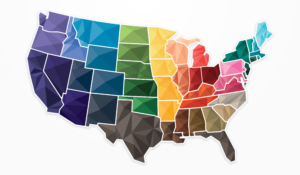COVID-19— Are your Remote Employees Creating Nexus?

In a recent blog, we discussed how the 2018 South Dakota v. Wayfair decision has been significantly impactful in altering the sales and use tax implications in majority of the states. As our readers know, the term “nexus” indicates the amount of contact necessary by a company in order to be obligated to collect sales tax in a state. In order to impose a tax obligation, nexus must be created – either by physical presence (for instance, employees, contractors, an office, or inventory in the state) or because of economic nexus, which measures the minimum amount of sales revenue or transaction volume that creates nexus and differs from state to state.
Nexus in a COVID-19 Environment
As the pandemic has forced employees to work from their homes, is it time to take a look at how that might unexpectedly create nexus for companies? Do teleworkers indeed create nexus for the businesses during a pandemic? Do states provide any exception to the physical presence rule for sellers who usually work in one state (the company location) but live (and now work) in another as a result of the COVID-19 pandemic?
Why Popular Food Delivery Services Face Tax Auditing
 Have you made use of a third-party food delivery service, like DoorDash, Postmates or Uber Eats? Millions of Americans do every day, and that number has only increased as a result of the COVID-19 pandemic and subsequent stay-at-home orders.
Have you made use of a third-party food delivery service, like DoorDash, Postmates or Uber Eats? Millions of Americans do every day, and that number has only increased as a result of the COVID-19 pandemic and subsequent stay-at-home orders.
According to Second Measure, through the end of May, sales for third-party food delivery services more than doubled on a year-over-year basis.
So, why is this a big deal, tax-wise? While these services have been on tax organizations’ radar for several years, the pandemic has highlighted the issue even further, especially as the third-party food delivery industry is one of the few that has thrived during the pandemic.
The main concern tax officials have is whether these third-party food delivery services are properly collecting and remitting taxes, particularly in the current post-Wayfair tax environment.
All combined, it’s the perfect tax liability storm.
Why Are States So Interested in Food Delivery Services?
As the third-party food delivery scene has grown over the last decade and a half, it has exploded into a multi-billion dollar industry, with current estimates from Statista projecting market revenue to reach $32 billion by 2024.
That sort of revenue is too good to ignore, especially as states look for additional revenue sources to off-set the economic impact of the shutdown.
Why Would Food Delivery Services Be Audited?
Looking at the potential revenue, it’s easy to see why states are so interested in the third-party food delivery market, but why are these services potentially facing audits? The simple answer is that due to the tax complexity in this market, it’s especially difficult to ensure that tax responsibilities are being met by these services.
First off, most states do not have specific guidance for the taxability of these services, leaving them in a nebulous grey-zone that is open to interpretation. Earlier this year, Georgia implemented a new marketplace facilitator law, which specifically included third-party food delivery services. This will likely pave the way for other states to implement similar guidance.
Beyond Wayfair-related complications, the very nature of food and beverage taxation causes additional problems. It’s one of the most complex tax areas to administer and rules vary wildly from state-to-state, or even within states. On top of that, the application of taxes to delivery fees is also inconsistent.
All these layers mean that properly complying with tax regulations, and ensuring that businesses are doing so, can be nightmarish.
Moving forward, we would expect to see tax agencies who have yet to issue specific guidance for third-party food delivery services, to do so soon. Additionally, taxation of these services may expand as states look for additional revenue sources.
Meanwhile, audits will almost certainly be issued for the biggest of the third-party delivery services. For the smaller apps, this offers a chance to ensure they are properly complying with applicable tax legislation.
Do You Have Questions About Tax Compliance?
If you have questions regarding tax compliance, third-party food delivery services or other tax questions, please contact us today. We’re happy to clarify any multi-state tax issues you’re trying to navigate.
Wayfair Two Years Later—What Have We Learned

It’s hard to believe that it has been two years since the landmark decision in South Dakota v. Wayfair (2018) that changed the sales tax landscape. The high court’s decision on June 21, 2018 was that South Dakota’s economic nexus law was constitutional and that the state could require companies who met certain sales thresholds to collect and remit sales tax on sales to South Dakota customers, even if the company had no physical presence. The decision effectively changed the way states define nexus for sales tax purposes.
The Supreme Court’s ruling did not automatically make this the law of the land for all 50 states. It was a South Dakota case, so the ruling just applied to South Dakota. However, in the last two years, states have been jumping on the economic nexus bandwagon and enacting laws similar to those of South Dakota. States have long been searching for new ways to bring revenue into their state and the Wayfair case gave them a long-awaited opportunity to do so.
A Focus on Puerto Rico’s Tax Climate
 In light of recent sales tax changes, this month, we'd like to take you to the Caribbean and discuss the Puerto Rico tax climate. An archipelago, it consists of the main island and a number of smaller ones, including Vieques, Culebra and Mona. Not every island is populated year-round, but many are popular tourist destinations.
In light of recent sales tax changes, this month, we'd like to take you to the Caribbean and discuss the Puerto Rico tax climate. An archipelago, it consists of the main island and a number of smaller ones, including Vieques, Culebra and Mona. Not every island is populated year-round, but many are popular tourist destinations.
Collectively known as the "Island of Enchantment," Puerto Rico features beautiful sandy beaches, gorgeous tropical forests, coral reefs and balmy weather.
The islands were first populated by the Taíno, an indigenous Caribbean ethnic group, before being colonized by the Spanish following Christopher Columbus' arrival in 1493. It remained in Spanish hands until the Spanish-American War, when it was ceded to American control with the signing of the Treaty of Paris of 1898.
As an unincorporated territory of the U.S., Puerto Ricans are U.S. citizens and can move freely between the island and the mainland. However, it does not have a vote in the U.S. Congress and is only represented by one non-voting member in the House of Representatives, referred to as a resident commissioner. Various taxes in Puerto Rico are often similar to those in the U.S., but can have significant changes based on local law.
In September 2017, the islands were ravaged by Hurricane Maria, resulting in significant human fatalities and damage to infrastructure. In December 2019 and January 2020, the islands were rocked by a series of earthquakes, resulting in additional damage to homes and other structures. Overall, recovery has been slow after the disasters, with federal disaster relief funds taking months, or years, to be distributed.
Tourism is an important economic industry for the islands. Popular tourist destinations include Old San Juan, which features 500-year-old buildings and other landmarks, and La Parguera, Lajas, a village on the southwestern side of the main island with a nearby bioluminescent bay.
The largest economic industry is manufacturing, primarily of pharmaceuticals, medical devices and biotechnology. Across the island, Puerto Rico has 49 FDA-approved pharmaceutical plants and the world's largest modular biotechnology plant for producing recombinant human insulin.
The Puerto Rico tax climate borrows from federal tax laws, but features legislation that is distinct from the rest of the U.S. For example, while they do not pay U.S. federal income tax, Puerto Rico does levy a personal income tax, with a top marginal rate of 33 percent. Additionally, they collect corporate income tax, with a maximum nominal rate of 37.5 percent.
Due to inheritance laws, Puerto Rico previously collected estate and gift taxes on property willed or inherited after a death. However, in August 2017, Senate Bill 582 was signed into law, which repealed both estate and gift taxes.
Property taxes are also collected, with a maximum tax rate of 9.83 percent.
Puerto Rico's general sales and use tax rate was increased to from 7 percent to 11.5 percent in 2015, with the tax rate on prepared foods lowered back to 7 percent following additional tax reform in 2018. Due to this, sales taxes in Puerto Rico are the highest in the U.S., with Tennessee (9.53 percent) and Louisiana (9.52 percent) second and third.
Recently, newly enacted legislation requires marketplace facilitators to collect and remit sales and use tax on all sales made through their platform in Puerto Rico. The law took effect retroactively on January 1, 2020. However, there is legislation currently pending that would move the effective date to October 1, 2020.
The legislation defines a marketplace facilitator as entities that facilitate the sale of tangible personal property, specific digital products or taxable services through promoting, advertising or listing the sales by marketplace sellers. Additionally, marketplace facilitators must directly or indirectly collect payment from the purchaser and transmit it to the marketplace seller.
Before the recent changes, Puerto Rico had been encouraging out-of-state sellers to voluntarily collect and remit tax on sales since July 2017. However, they haven't been compelled until now.
In regards to the taxation of technology products for sales tax purposes, Puerto Rico imposes sales and use tax on tangible personal property, which includes items, "that can be seen, weighed, measured or touched, or in any other way perceptible to the senses, or that is susceptible to appropriation, regardless of the means of delivery or transfer." This includes computer software and digital goods such as e-books. There is currently no guidance regarding software-as-a-service goods or cloud-based services.
Many states have annual sales tax holidays, during which certain items the state wants to promote the purchase of (like school supplies, emergency preparedness supplies, or energy efficient appliances) can be purchased sales tax free. Puerto Rico holds back to school sales tax holidays, which apply to school uniforms and applicable supplies.
- San Juan is in the top 25 busiest cruise ports in the world by passengers.
- Puerto Rico uses the U.S. dollar.
- El Yunque Rainforest, located on the main island, is the only tropical rainforest that is part of the U.S. National Forest System.
- Christopher Columbus originally named the island San Juan Bautista, after John the Baptist.
- The national drink of Puerto Rico is the Piña Colada.
- There are over 270 miles of beaches in Puerto Rico.
- Several beaches in Puerto Rico have black sand due to volcanic activity.
- For over 50 years, the largest radio telescope in the world was located in Arecibo, Puerto Rico.
Sales Tax Reliance

Have you ever gone to the store, bought something, looked at your receipt and said to yourself, “This item only cost $25, why did I pay $28 for it?” Well $3 was due to sales tax, which many people STILL fail to mentally figure in before going to the register. You may gasp and think to yourself, “Gosh, this amount is really high.” Well you were probably in a state that relies heavily on sales tax for revenue.
According to a study by the Tax Foundation in 2017, sales tax is the second largest source of state and local tax revenue behind property taxes .
States Enjoy Boost in Tax Revenue from Increased Ecommerce
 While the COVID-19 pandemic has been hard, if not downright disastrous, for businesses and governmental agencies across the country, states are now seeing a small ray of hope in the form of online sales tax revenue.
While the COVID-19 pandemic has been hard, if not downright disastrous, for businesses and governmental agencies across the country, states are now seeing a small ray of hope in the form of online sales tax revenue.
With many people self-quarantining at home and brick and mortar retail locations closed over the last several months, ecommerce has been the shopping avenue of choice across the nation.
Additionally, the adoption of marketplace facilitator and economic nexus legislation over the past two years as a result of the South Dakota v. Wayfair ruling has also played a part. For states that have implemented these laws, the boost in ecommerce has compounded with the increased tax revenue these states are seeing from Wayfair legislation.
States have seen an increase in ecommerce across the board. According to data from Adobe Analytics, ecommerce grew by 25 percent from March 13-15 compared to March 1-11. Online retailers have also seen average year-over-year revenue growth of over 68 percent and have recently experienced similar online activity to the 2019 holiday season.
So, what does this mean for online sales tax revenue? As ecommerce rises, the collection and remittance of online sales tax also rises.
As shared by Bloomberg Tax, recent online sales collections in Vermont demonstrate this. Typically, Vermont sees less than 12 percent of its monthly sales tax collections come from online sales. However, since Vermont entered a state of emergency on March 13, that percentage has at least doubled. According to Bloomberg Tax, many states have seen online sales tax revenue increases ranging from 25 percent to 100 percent in comparison with data from 2019.
In a time when states are projecting revenue shortfalls by the hundreds of millions as a direct result of COVID-19, the impact of increased ecommerce and online sales tax revenue may seem like a drop in the bucket. However, the combination of both increased ecommerce and marketplace facilitator legislation is nothing to scoff at.
For instance, California's economic nexus and marketplace facilitator law, which was implemented April 1, 2019, was estimated to bring in revenue of $309 million in fiscal year 2019-20 alone. Now, after the increased ecommerce as a result of COVID-19, the actual amount will likely be higher than projected, though by how much is yet to be seen.
While online sales tax revenue is not a solution to the economic problems faced by states, it is certainly a bandage that can help stem some of the fiscal bleed.
If you have questions regarding online sales tax, marketplace facilitation or other tax questions, please contact us today. We're happy to clarify any multi-state tax issues you're trying to navigate.
Focus on Wyoming

This month, we take you to the western mountain region of our country. Wyoming’s natural beauty and mountain ranges offer a sense of adventure, and perhaps a sense of rugged courage that surrounds you with the Western spirit. Popularly known as “The Equality State” and “The Cowboy State”, Wyoming is the least populous state and the 10th largest state by area in the country. The state is also the 2nd most sparsely populated after Alaska. It was named after a Native American word “mscheweamiing” meaning “at the big flats” or “Large plains.”
How to Apply for PPP Loan Forgiveness

In last week's blog, we discussed the continuing confusion surrounding the deductibility of eligible expenses by small businesses who have received loans through the Paycheck Protection Program (PPP). While that situation has yet to be fully resolved, another aspect of the PPP program, applying for loan forgiveness, is a bit clearer cut.
You might ask, "why are you writing about the PPP loan forgiveness in a multistate tax blog?" The answer is simple. One of the things we are proudest of, in our state tax consulting space, is that we too, are a small business. And we've had first-hand experience in working through the complexities of this process. We felt it was important enough from a national small business perspective to warrant some dedicated space!
Loans through the PPP are applicable for forgiveness, but to be forgiven, the funds must be used to cover the following:
- Payroll costs, including benefits (up to $15,385 per worker)
- Interest on mortgage obligations, entered into before February 15, 2020
- Rent, under lease agreements in force before February 15, 2020
- Utilities, for which service began before February 15, 2020
In addition, employee and compensation levels must be maintained, or employees must be quickly rehired. Plus, no more than 25 percent of the forgiven amount may be for non-payroll costs.
To ensure small businesses owners will not be required to pay back large portions of PPP loans, it's important they calculate eligible expenses. In the weeks since the implementation of the PPP, many business owners have anxiously awaited further guidance regarding the application process and exact information regarding calculating loan forgiveness.
On May 15, the Treasury Department and the Small Business Authority released a Loan Forgiveness Application, which includes instructions and additional information for business owners.
By following the directions as described in the application, business owners will be able to calculate their forgiveness amount and submit required documentation.
Keeping accurate records regarding total eligible costs during the 8-week covered period after receiving loan funding is critical to securing loan forgiveness.
The main considerations for loan forgiveness are:
- The amount of funds used for eligible payroll: If payroll equates less than 75 percent, loan forgiveness will be reduced.
- Average Full-Time Employees (FTE): If the average weekly number of full-time employees during the covered period of the PPP loan was less than either Feb. 15 - June 30, 2019 or Jan 1 - Feb 29, 2020, loan forgiveness may be reduced. Seasonal employers can use a consecutive 12-week period between May 1 - Sept. 15, 2019.
- Salary and hourly wage reductions: If salary or hourly wages of certain employees during the covered period was less than from Jan. 1 - March 31, 2020, the amount of loan forgiveness may be reduced.
- Full-Time Employee Reduction Exceptions: Good-faith, written offers to rehire employees during the covered period that were rejected, or employees who were fired for cause, voluntarily resigned or voluntarily requested a reduction of hours will not count against loan forgiveness.
In addition to filling out the form and submitting it to their lender (or the lender servicing their loan), small business owners will be required to submit supporting documentation detailing payroll costs, FTE information and details verifying obligations for mortgage interest payments, rent or lease payments and business utility payments.
If you have questions regarding the PPP and loan forgiveness, please contact us today. We're happy to clarify any multi-state or PPP/CARES tax issues you're trying to navigate.
The Miles Consulting team is wishing you and your family continued good health and safety in these trying times.
Do You Know If You Can Deduct Expenses with a PPP Loan?
 It’s been nearly a month and half since the Coronavirus Aid, Relief, and Economic Security Act (CARES) established the Paycheck Protection Program (PPP). In the time since, countless businesses across the country have applied for aid. Congress has also passed the Paycheck Protection Program and Health Care Enhancement Act, which added an additional $320 billion in funding after the first $349 billion was allocated.
It’s been nearly a month and half since the Coronavirus Aid, Relief, and Economic Security Act (CARES) established the Paycheck Protection Program (PPP). In the time since, countless businesses across the country have applied for aid. Congress has also passed the Paycheck Protection Program and Health Care Enhancement Act, which added an additional $320 billion in funding after the first $349 billion was allocated.
During this time, there have been various criticisms of the program, with many questions coming from small business owners. Many tax experts and economists also have unanswered questions regarding the program. One of the most asked questions is, will small businesses who have received PPP loans be allowed to deduct expenses?
Deductibility For PPP Expenses
While the CARES Act does contain language that specifically excludes loans forgiven under the PPP from being taxable income at the federal level, it also conflicts with other areas of tax code, which initially led to confusion amongst small business owners and tax officials alike.
Specifically, Section 265 of the tax code states that businesses cannot deduct expenses associated with tax-free income. This creates conflict because tax-free loan forgiveness without deductions is the same as allowing deductions when forgiven loans are treated as taxable income.
Following the initial confusion, the IRS issued a notice on April 30 which said small businesses couldn’t deduct expenses if they receive a PPP loan. Specifically, it states that deductions are not allowed “for an expense that is otherwise deductible if the
payment of the expense results in forgiveness of a covered [PPP] loan…”
However, on May 5, lawmakers introduced S.3612, a bill which, if passed, would enable small businesses to deduct expenses, effectively invalidating the IRS notice.
Also on May 5, several sponsors of the bill sent a letter addressed to Treasury Secretary Steven T. Mnuchin, in which they noted that the guidance from the IRS on April 30 is contrary to Congressional intent when the PPP was created.
In the letter, the sponsors stated “Providing assistance to small businesses, only to disallow their business deductions… reverses the benefit that Congress specifically granted by exempting PPP loan forgiveness from income.”
The bill was referred to the Committee on Finance for further consideration.
In the meantime, the guidance from the IRS stands, and until the fate of S.3612 is decided, small business owners will need to keep that in mind moving forward. However, the ultimate answer to the question of deductibility is still left unanswered.
And, if you think it’s unclear at the federal level, the next question is – how will the states treat the deductibility issue? Stay tuned. Hopefully once the dust settles and a decision is reached at the federal level, the states will weigh in on guidance. We expect it to be a mixed bag, with some states conforming to federal rules, and others not.
Do You Have Questions About the PPP?
As developments for the CARES Act and PPP continue to come, we will be keeping a close eye on the situation and will be providing updates as the situation continues to evolve.
If you would like to know more about pending legislation regarding the PPP and how it could impact your business, please contact us today. We’re happy to clarify any multi-state or PPP/CARES tax issues you’re trying to navigate.
As always, we wish you and your family continued good health and safety.
CDTFA Amends its "Collection of Use" Tax Regulation—Part 2

Use Tax" Regulation?
If you’ve been following along with our blogs, you know that we talked about some new amendments taking place under California Sales and Use Tax Regulation 1684, “Collection of Use Tax by Retailers”. In the first part of our blog, we discussed how California implemented on April 1, 2019 an economic nexus threshold for retailers in addition to the longstanding physical nexus threshold. The State now requires out of state sellers to register and collect use tax in California as soon as they exceed $500,000 of sales of tangible personal property in either the preceding or current calendar year.




















